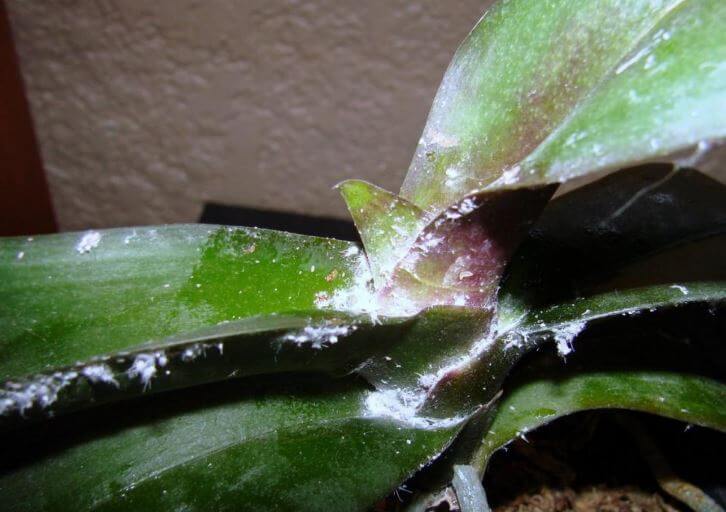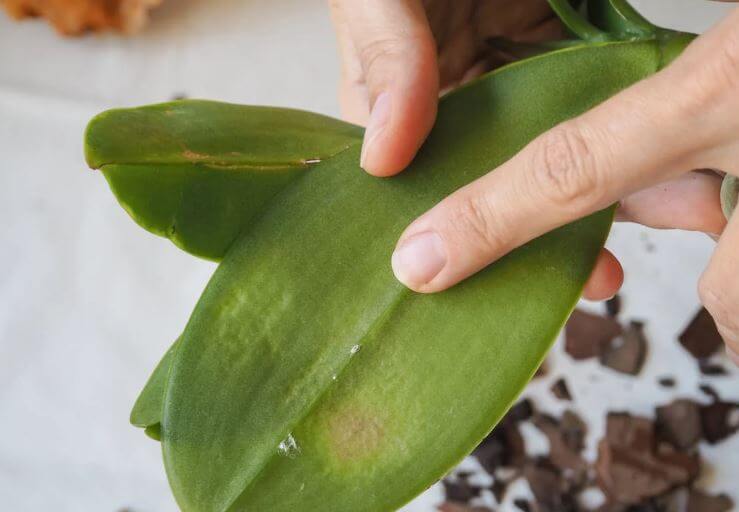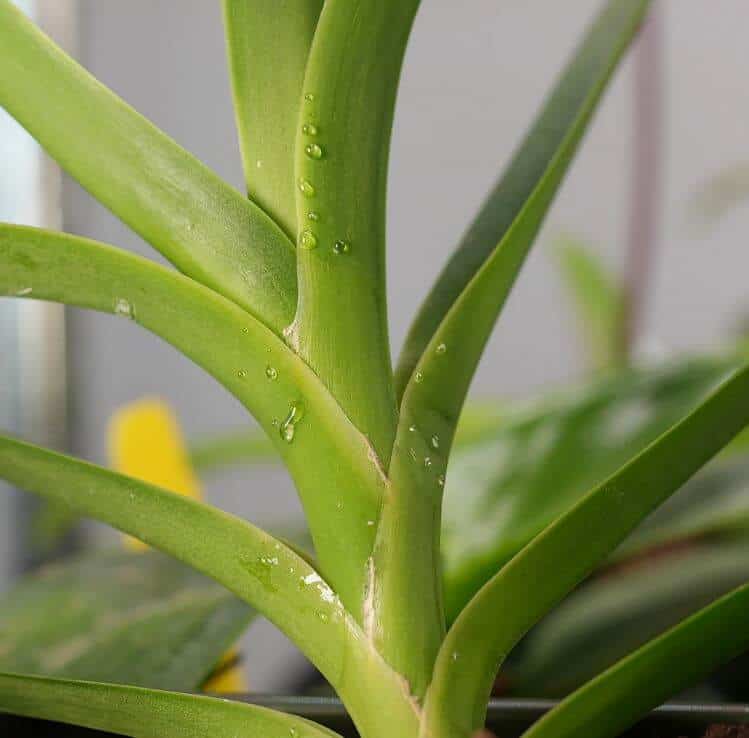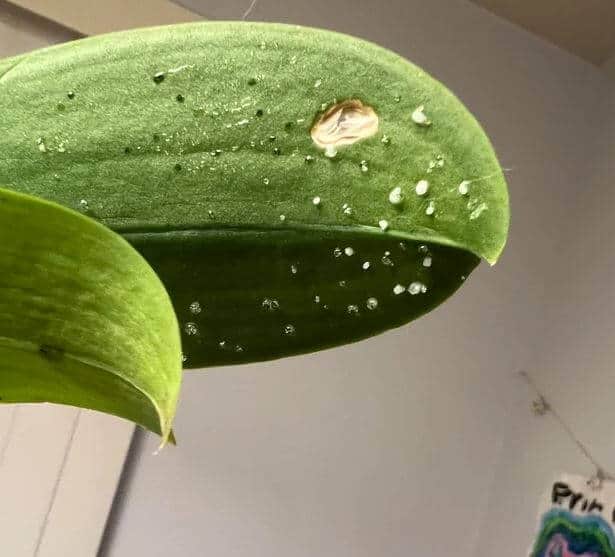Last Updated on July 24, 2023 by a Friendly Gardener
If you have recently examined your orchid plant and found sticky stuff on its leaves, you may be worried. Don’t panic! Theoretically, leaves shouldn’t be covered in goo, so why do you have orchids with sticky stuff on the leaves? There are a couple of reasons this condition may develop, so it’s important to identify the cause before you take action. Often, sticky clear sap is normal for your orchid and will wash off easily while in some cases it may be a cause for alarm. Let’s look at why orchid leaves are sometimes covered in sticky stuff.
What Is the Sticky Stuff on Orchid Leaves?

Commonly the sticky stuff you are finding on your epiphyte’s leaves may be:
-
Honeydew secretions

Honeydew is naturally produced by orchids. This sap is referred to as happy sap, orchid sap, or orchid nectar. If your orchid is in bloom or about to bloom, it may produce larger quantities of its sap. The sap is full of nutrients and is used to nourish new plant tissue.
If there is no evidence of a pest infestation, your orchid looks healthy and had proper watering, there is no reason to worry as this condition is natural, If your plant has buds, see if the sap is being produced directly from the blossom, the peduncle or the pedicle. If so, the sap dripping from the plant is entirely normal and your only concern will be to keep the foliage clean and not harm leaves when cleaning them. Phalaenopsis, Oncidiums, and Cattleyas commonly produce orchid nectar to cite a few.
Sap needs to be removed promptly as if it is left on leaves it can create the conditions for other issues such as the death of leaf cells. Leaf cells breathe so if a thick sticky substance is left on foliage for too long, the leaf will not only have difficulty breathing, but there will also be inadequate gas exchange and insufficient light absorption for photosynthesis. The top layer of leaf cells will die creating the ideal environment for bacteria to develop and destroy the foliage.
Sticky stuff on orchid leaves also attracts pollinators due to the high sucrose content in the sap. You may find your orchid overrun with undesirable bees, ants, and other insects. Left to their own devices, pests will gradually destroy the plant because of new tissue and buds for their high nutritional value and level of hydration. Fungal infections may also attack and can develop into sooty mold. Sooty mold can be lethal if left untreated.
Consider the amount of sticky sap you find on foliage. Lots of sticky stuff generally indicates a pest infestation while several drops of orchid nectar may be the plant itself producing the sap.
-
Insect excretions
Certain pests will also excrete a sticky substance leaving it on foliage when feeding on the orchid. Orchids are unable to fight pests without help. If you see ants around your orchid leaves, investigate further for a pest infestation. Ants usually are a telltale sign of an advanced pest infestation. The sap excreted by pests will not kill the orchid because it contains smaller amounts of sugar. Yet, even if insect excrements are not a problem, the pests themselves are. Insects will feed on the plant destroying plant foliage and buds.
Three common types of pests will leave excrement in the form of a sticky substance on your orchid leaves: scale, aphids, and mealybugs. If you suspect pests, treat your orchid with an organic insecticide such as neem oil which will kill insects during their various life stages including eggs, larvae, and adults. Repeat as often as necessary until you are certain you have eliminated all the pests. Neem oil is also helpful in warding off fungal infections as it is also an organic fungicide.
-
A release of hydration pressure

When sticky stuff appears on the undersides of orchid leaves, this is generally an indication that your plant has absorbed too much water. The release of sap is an attempt by the plant to relieve a pressure buildup due to excess water. You may also see the development of tiny water blisters on the leaves that then explode. This is plant edema. While not fatal, you will need to adjust your watering routine. Orchids like moisture but they will not stand for being soggy.
In this case, the water will emerge from the leaf underside and will crystallize due to the high sugar content within the sap. Leaves must be cleaned very carefully to leaf pores are not damaged in the process. Use a dampened cloth and gently wipe the leaf undersides clean.
Can You Leave Clear Sticky Stuff on Orchid Leaves?

No, you avoid leaving sticky sap on your orchid’s foliage or stem. Even if your plant has produced this sap, it still needs to be removed. When sticky sap is left on orchid leaves, this residue often develops sooty mold or it can attract pests, so it’s better to protect your plant by removing this sticky residue.
Use a moistened cloth and wipe affected leaves and stems gently. Make it a point to support the leaf during cleaning to prevent splitting or breakage. Warm water will facilitate the sticky sap removal. If removal proves to be difficult use a gentle soap mixture. Once the sap has been removed, rinse off the soapy mixture and dry the leaves when finished.
What About Discolored Sticky Stuff on My Orchid Leaves?

Brown or black sticky stuff on orchid leaves generally indicates that your plant has either a bacterial or fungal infection. This is very common with sooty mold. Left untreated, slimy areas will develop on foliage and eventually spread, stunting growth and causing the death of your plant.
If you suspect an infection, isolate your orchid from other plants to prevent the spread. Prune off all infected parts with sterilized scissors. Dispose of infected plant parts. Treat the cut edges with ground cinnamon powder to prevent further infection.

